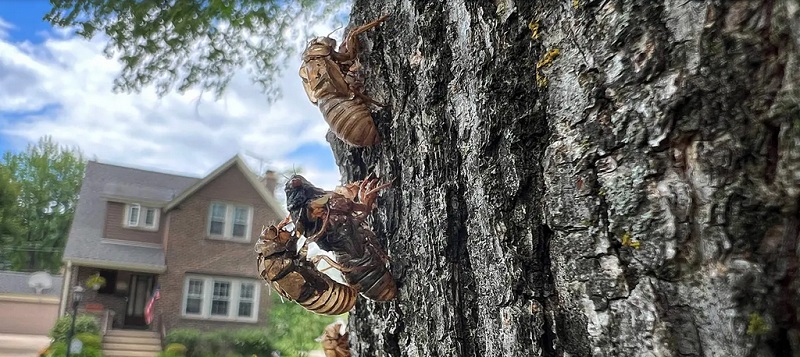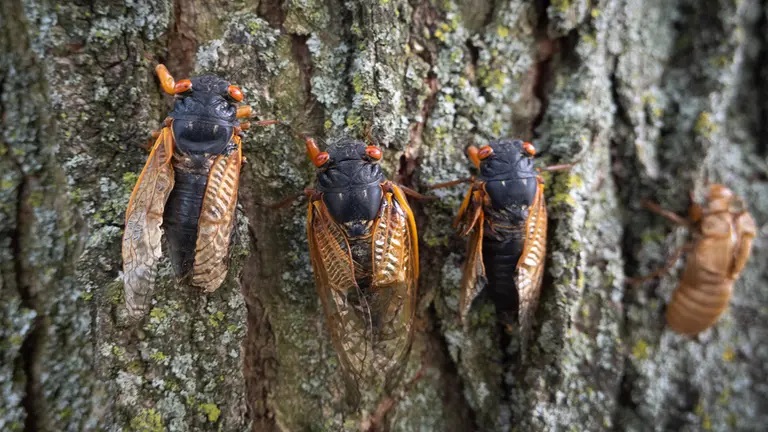The Phenomenon of Cicadas: A Spectacle of Nature and Curiosity in the United States
Every 221 years, a unique natural spectacle unfolds in the United States as two populations of cicadas emerge from their underground habitats simultaneously, filling the air with their deafening mating songs. This extraordinary event, characterized by the emergence of billions of cicadas from the XIII and XIX populations in states like Illinois and Virginia, captivates enthusiasts, scientists, and curious onlookers alike. As these insects make their brief appearance to fulfill their life cycle, they inspire fascination, wonder, and, in some cases, unusual culinary experiments.
The Cicada Emergence: A Rare Event
In locations such as the Ryerson Woods Preserve north of Chicago, the emergence of cicadas is not just a natural occurrence but a momentous event that attracts attention and curiosity. This year, amidst the lush greenery of the preserve, one and a half million red-eyed cicadas have surfaced, creating a cacophony of sound that reaches 110 decibels, akin to the noise of a jet engine preparing for landing. The air is tinged with a slightly putrid scent as the discarded exoskeletons of the hatched larvae litter the ground.
To educate visitors about the behavior and life cycle of these fascinating insects, the preserve hosts a cicada festival, where children donning cicada costumes explore interactive displays and learn about the biology of these creatures. Experts like Gene Kritsky from Mount St. Joseph University share their knowledge with eager attendees, shedding light on the ecological significance and evolutionary adaptations of cicadas.
Intersecting Populations and Culinary Delights
The convergence of the XIII and XIX cicada populations, occurring every 221 years, adds an element of rarity and intrigue to this year’s emergence. Despite the lack of geographical overlap between these two groups, their synchronized appearance has excited scientists and enthusiasts, drawing attention from international media outlets and nature enthusiasts.
Capitalizing on this event, chef Rafa Esparza from a trendy restaurant in Chicago introduces cicadas to his menu in various innovative dishes, ranging from cicada pasta to cocktails adorned with cicada decorations. While the inclusion of cicadas may be perceived as a gimmick, Esparza attests to their nutty flavor and culinary appeal, catering to adventurous diners keen on exploring novel gastronomic experiences.
Curiosities and Scientific Insights
As conversations unfold between chef Esparza and Professor Kritsky, revelations about the unique characteristics of cicadas emerge. The presence of zombie cicadas, infected by a fungus that induces hypersexualized behavior, offers a glimpse into the intricate interplay between parasites and their insect hosts. While the psychedelic effects of these fungi on cicadas provide a captivating narrative, reassurances are provided that human consumption of infected cicadas poses no risk of psychedelic experiences due to the low concentration of active compounds.
Exploring Nature’s Wonders and Culinary Creativity
The saga of the cicadas, with their enigmatic life cycle and periodic emergences, serves as a reminder of the diversity and resilience of nature. By immersing ourselves in the wonders of the natural world and embracing the curiosity sparked by extraordinary events like the synchronized emergence of cicada populations, we gain insights into the intricate web of life and the interconnectedness of ecosystems.
As chef Esparza returns to his kitchen with a container of nymphs to experiment with new culinary creations, he embodies the spirit of curiosity and innovation that drives exploration and discovery. Through his culinary endeavors, he bridges the realms of science and gastronomy, offering diners a taste of nature’s wonders and the opportunity to savor the flavors of a truly unique spectacle.
In conclusion, the phenomenon of billions of cicadas chirping in unison underscores the beauty and complexity of the natural world, inviting us to marvel at the wonders of evolution and adaptation. As these insects serenade the forests with their mating songs and inspire culinary explorations, they serve as a reminder of the enduring enchantment and fascination that nature holds for those willing to embrace its mysteries and marvels.


